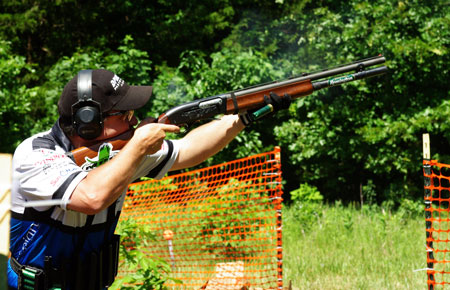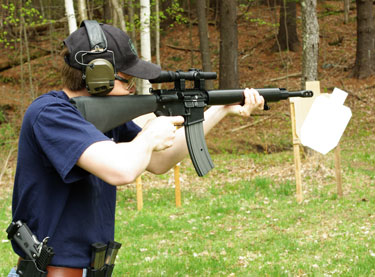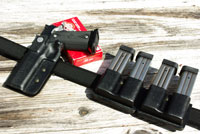 |
| Bruce Piatt shooting his shotgun during the Midwest Three-Gun Championships. |
Three-gun shooting, as the name implies, features the use of handguns, rifles and shotguns. It can encompass long-range precision shooting or ultra close, “hose ‘em down” situations and everything in between, sometimes all in one stage. This sport moves fast and draws on every shooting skill you possess. The shooting is “practical” style, which means it simulates combat or self-defense. You will have a “scenario” at each stage that will have you shooting one or more of the guns in a specific sequence. Each stage is different and every match is different. This is not like skeet or bull’s-eye shooting, when you know what the target will be every time; in fact it is quite the opposite. Each time you step up to a stage it is likely that you will encounter a shooting challenge that is different from any in your past. It’s up to the shooter to figure out a strategy and hope it’s one that wins.
There are several classes and a couple of sets of rules. That leads to plenty of options for firearms, but new shooters usually start with the most popular class, Tactical Optics. This is the class that is most likely to fit with the firearms you already own. In this class the shooter is allowed one optic and it is almost universally on the rifle. The handgun and shotgun will not have optical sights.
Remember, even if you don’t have everything you need to start, if you pool with your buddies you might find that you do. You can shoot together on the same squad and share firearms. So if you have a rifle, somebody else has a handgun and another a shotgun, you can all shoot. This gets you started, but be warned, three-gun is addictive and you will find yourself buying more guns once you try it.
How can that possibly be a bad thing?
Guns That Will Get You in the Game
Rifles
Three-gun, or multi-gun as it’s called in some circles, is the domain of the AR-15 type rifles, but most any rifle meets the rules. At my first match I saw a party of three sharing the same SKS rifle and loading with 10-round stripper clips. They didn’t win, but they sure were having fun! The next time I ran into the guy who owned the SKS he had a top-of-the-line competition AR and an addiction to three-gun that had him grinning ear to ear.
Bottom line, if you have an AR-15 type rifle and a couple of 30-round magazines (and who doesn’t?) you can start shooting without a lot of limitations. Even if you do not, most any other type of semi-auto “tactical” rifle will get you in the game and allow you to get your feet wet.
 |
| Nathan Towsley with Bryce Towsley's DPMS competition rifle. |
When you decide to build or buy a competition rifle, there are a few things that will trick out the rifle in your favor. The .223 Rem./5.56 chambering is king. A muzzle brake is very important if you are going to be competitive. You can shoot well without one, but if you are going to run with the big dogs, sooner or later you will need a muzzle brake. These help manage recoil and reduce muzzle flip for fast, repeat shooting.
The barrel length should be somewhere around 18 to 20 inches. Barrel weight is subject to personal preference, but most prefer a slightly heavy contour to put a little weight out in front and to handle the heat of multiple shots better. A 1:9 twist will work, but a 1:8 twist rate will allow you to use heavier bullets if you have some long-range reactive steel targets. A good trigger is very important.
I like a standard A2-style fixed stock, but a lot of shooters use a collapsible stock because it offers so many options on length of pull to fit different shooting positions. Use a rifle style gas tube to allow the use of a long forend. This allows you to reach out on the rifle for better control. Most shooters seem to prefer a round forend as the rail type forends will make the shooter’s hands sore by the end of the day.
Thirty-round magazines are the standard. But you will probably want at least one extended capacity magazine. There are several on the market. I have a DPMS 45-round that I use a lot. Under IDPA, and perhaps others, you must have a “stick” style magazine; drums are not allowed in the tactical class.
The best optic is a low power. The idea is that the low end magnification allows shooting at the very close targets, while the upper end magnification is enough for the long-range shots. The key here is versatility and durability. Don’t scrimp on the optics as they take a beating and only the toughest survive.
You will probably want an ambidextrous safety, also a tactical bolt catch. This is important because the shooter is often required to clear a rifle and lock the bolt back to make it safe while on the clock. This bolt catch has a big pad to push to lock the action open and keep the “fumble factor” to a minimum. If you fail to lock the bolt back, it’s an automatic disqualification in most matches. A tactical, extended charging handle helps with the reloads.
My choice for rifles is DPMS and they have a provision on line to customize your rifle to any configuration you wish. (800) 578-3767 www.dpmsinc.com.
Shotguns
If you already have a semi-auto shotgun you are ready to compete. You probably will want to add an extended magazine. But, that’s easy to do and inexpensive. The 12-gauge is the most popular. Often there are reactive steel targets and it provides enough power to slap them down.
Some rules require a short barrel, so you will probably replace your bird gun barrel (or entire shotgun) with something more “tactical” down the line. The most common configuration is a semi-auto with a 20-inch to 22- inch barrel and an extended magazine that holds eight shots, for a total of a nine-shot capacity, the maximum allowed in tactical class. Eventually you will want to add extra touches like an oversize safety button and larger carrier release. Most shooters like some sort of sights for the slug stages. The key to success in many matches is being able to reload the shotgun fast, so a sidesaddle ammo carrier is almost a must.
This game is tough on a shotgun and only the strong survive. A lot of guns that have good reputations in the hunting fields can’t stand up to the thousands of shots and rough handling. One can, Benelli. That’s why I picked an M-2 for my new competition gun. www.benelliusa.com (301) 283-6981.
Handguns
You can shoot with any semi-auto centerfire handgun and get started. I shot my first match with the same gun I use in USPSA, a Kimber 1911 Team Match. But, this is a game designed for high-capacity handguns and I found out quickly the disadvantage of a 10-round magazine. Plus the recoil of the .45 ACP slowed me down.
 |
| Bryce M. Towsley's STI handgun in .40 S&W. Holster by Hillsman Holster Company. |
I switched to a Glock 34 competition gun in 9mm. This is a high-capacity handgun with low recoil and is a good way to get started. Of course, it’s just temporary until my custom STI switch-barrel in .40 S&W and 9mm is completed. The reason for two calibers? Three-gun is still the frontier in terms of who regulates and who makes the rules, which I like. Too many rules are what spoiled a lot of other shooting sports. So, in many matches there is no power factor to consider and the 9mm is a good choice. The low recoil and high capacity make it a very competitive handgun. But, at some matches the various ruling bodies have a power factor requirement and the 9mm is too wimpy to qualify. So, in that situation I shoot a .40 S&W.
Which gun is best? It’s hard to say. A lot of shooters seem to favor the .40 S&W because it’s legal in all matches. If you shoot the 9mm in the matches with a power factor you lose nothing if you center your hits. But, if you have marginal hits they will score lower than with a more powerful gun. So if you shoot well, you give up nothing.
Any high-capacity handgun will work fine. The most common handgun in the top shooters I have talked with is the STI, a high-quality, 1911 style high-capacity handgun. They are known for accuracy and reliability. (512) 819-0656 www.stiguns.com.
Other Stuff You Need
You will need a way to carry spare ammo, so belt pouches for the handgun and rifle magazines are important somewhere down the road. Don’t let the lack of them keep you from your first match, just stick the mags in your pockets if you have to. Here are a few suggestions based on what I have been using and what’s working for me.
Obviously you will need a holster for your handgun. Off the shelf I have had good luck with the Blackhawk Serpa holster for my GLOCK. 1-800-694-5263 www.blackhawk.com.
But, a custom gun needs a custom holster and I had my left-hand holster for the STI handgun and the mag pouches made by Hillsman Holster Company. The craftsmanship and quality is excellent. They worked with me to determine what would work best with my body type and shooting style and then designed the holster accordingly. 713-560-2454 www.hillsmanholster.com.
It is necessary to carry a few extra rifle magazines during the competition in a way that allows them to be accessed quickly, but still keeps them secured while running and moving. I use a couple of AR-15/M16 Kydex magazine pouches from Brownells. 800-741-0015 www.brownells.com.
For the shotgun you will need plenty of extra ammo available. Tacstar (800-423-9704 www.tacstar.com) has an inexpensive sidesaddle that will hold six rounds, which is just a start. I have shot in some stages where I used close to 50 rounds. A shell belt will work, but most shooters like the belt mounted speed loaders, which Brownells has. Also look at arm bands, bandoliers and any other creative way to hold shotshells. I have been using some of that stuff from Mark Otto, available at www.triangleshootingsports.com or www.shootersconnection.com.
Ammo? When I am shooting factory ammo I use Federal for one-stop shopping as they have ammo for all three guns. www.federalpremium.com.
Transporting the guns and ammo is also an issue. The Blackhawk 44-inch weapons case will hold the rifle and short-barreled shotgun as well as the pistol in the side pocket. The new Three-Gun Competition case from Brownells is a bit longer and easily accepts a 24-inch barreled shotgun. It also has backpacking straps to help carry the load. Put the ammo in a range bag to carry in your hand and you are good to go.
A much easier way is to use a cart. Mine is from Rugged Gear and is designed to hold three long guns, but I have modified it to hold four. It also will carry all my ammo and other gear, including a few water bottles. It’s easy to push, even with a full load. Best of all, they are not all that expensive. 1-800-784-4331 www.ruggedgear.com.
The best endorsement is what my buddy Bruce Piatt, one of the top shooters in the world said about this game, “Three times the guns – three times the fun!” GDTM

![Best Concealed Carry Guns In 2025 [Field Tested] Wilson Combat EDC X9S 1](https://gundigest.com/wp-content/uploads/Wilson-Combat-EDC-X9S-1-324x160.jpg)


![Best 9mm Carbine: Affordable PCCs [Tested] Ruger Carbine Shooting](https://gundigest.com/wp-content/uploads/Ruger-Carbine-Shooting-100x70.jpg)
![Best AR-15: Top Options Available Today [Field Tested] Harrington and Richardson PSA XM177E2 feature](https://gundigest.com/wp-content/uploads/Harrington-and-Richardson-PSA-XM177E2-feature-100x70.jpg)
